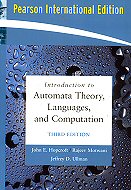Introduction to Automata Theory, Languages, and Computation
Third Edition
|
|
John E. Hopcroft, Rajeev Motwani, Jeffrey D. Ullman
|

|

[…] If you compare this book with the 1979 book, you will find that… this book is "larger on the outside, but smaller on the inside"… we are happy with the changes for several reasons…
Today, there is little direct research in automata theory (as opposed to its applications), and thus little motivation for us to retain the succinct, highly mathematical tone of the 1979 book. […]
The role of automata and language theory has changed over the past two decades.[…] Today, the subject is a staple of the undergraduate curriculum. As such, the content of the book must assume less in the way of prerequisites from the student, and therefore must provide more of the background and details of arguments than did the earlier book.
A third change in the environment is that Computer Science has grown to an almost unimaginable degree in the past three decades.[…] Today very many subdisciplines compete for the limited amount of space in the undergraduate curriculum. […]
[…] Some years ago, we found that many graduate students came to Stanford with a course in automata theory that did not include the theory of intractability. As the Stanford faculty believes that these ideas are essential for every computer scientist to know at more than the level of "NP-complete means it takes too long," there is another course, CS154N, that students may take to cover only Chapters 8, 9 and 10. They actually participate in roughly the last third of CS154 to fulfill the CS154N requirement […]
|
|
